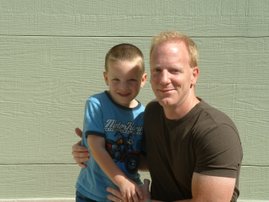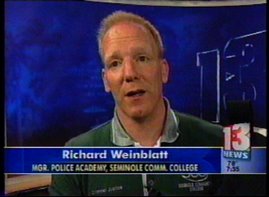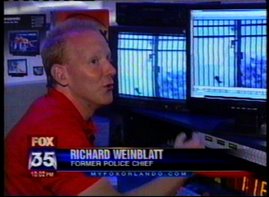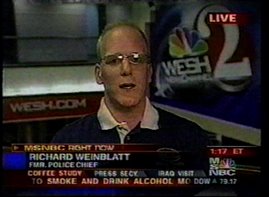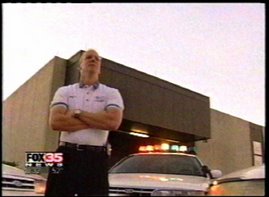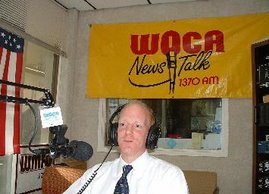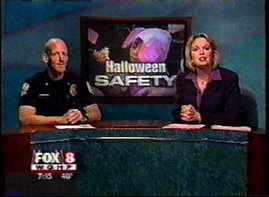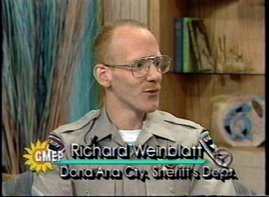The recent tragic office building shooting in Orlando, Florida, underscores my quick move to offer kudos to the Orlando Police Department in their quick response. Patrol officers were on scene in approximately one minute. As I explained in three live breaking news MSNBC TV interviews and the MSNBC.com website, as well as for local stations in Orlando, FL, (WESH 2 - NBC - News and Central Florida News 13) and Columbus, OH, (WCMH NBC 4 News), first responding patrol officers moved quickly and may have moved the shooter to leave sooner than he originally intended. They exemplified what we want to see in our law enforcers in times of crisis: brave decisive action backed by training and experience. When others run away, these men and women lived up to their oaths and ran towards the danger zone.
I detailed too quite a few show bookers, producers, news anchors and reporters, law enforcement response to active shooter situations changed historically at the Columbine High School incident in Colorado. As many will recall, that situation saw first responding patrol officers standing by waiting for SWAT team officers. Meanwhile, students were being shot and the gunmen moved through the structure unfettered.
Law enforcement trainers took a hard look at response tactics in those situations and a new approach was born that was used in Orlando, as as well in the Ft. Hood shooting in Texas. The idea is to have first responding patrol officers form small, mobile teams to dynamically and aggressively move towards the sound of gunfire or where the perceived threat may be. Along the way, they encounter people who they shoo behind them towards hopefully other arriving teams of officers. I'm not detailing the formations of these teams or other tactical details that could compromise the officers and the public.
I was involved in this training when it started and evolved. I found it to be an effective means to, in our parlance, neutralize the threat. It is training that is grounded in much thought and research. I know this training and I know the law enforcement agencies involved in the Florida response. Since I ran an Orlando-area Police Academy at Seminole Community College, I trained many of the men and women that responded on November 6, 2009.
The Orlando Police Department, as well as the Orange County Sheriff's Office, are known for their unusual proficiency via a bunch of training hours and resources devoted to this method. Jason Rodriguez, the Orlando shooter, picked the right part of the country (from my perspective) as the officers in Central Florida are among the best in the nation at this type of call for police service.
On a related note, for those who think that I am anti-law enforcement in my news interviews, you haven't watched more than a few of my interviews or visited my website (such as www.TheCopDoc.com). My recent stance on the excellent work of the Orlando Police Department certainly underscores that. Many of them are available for viewing on my youtube.com channel (http://www.youtube.com/user/richardweinblatt).
What is interesting is that I have a chorus of folks who feel that I only take the side of the po-po given my background in law enforcement. Both are far from the truth. Sometimes I side against law enforcement's actions in a particular matter. Other times, I defend their actions. And still other incidents I have taken a middle of the road neutral stance given that not enough facts were presented yet.
I let the facts speak for themselves and, coupled with my training, education, and experience, assess and communicate a professional opinion of complex justice issues in terms that are understandable. That has been a central part of my life's mission.
That my mission can help to highlight and explain the laudatory action of law enforcement officers in Orlando and Ft. Hood is particularly satisfying. Some of the TV news interviews are featured below.
Tuesday, November 17, 2009
Orlando Office Building & Ft. Hood Shooter Situation: Excellent Police Response
Labels: Active, Ft. Hood, New Orleans Police, Orange County, Orlando, Richard Weinblatt, sheriff, Shooter
Tuesday, July 21, 2009
Harvard Professor Gates and Racial Profiling: Police Expert's Perspective

As a college criminal justice educator, police expert media commentator, and former police chief, I have commented extensively police situations and have done so before on everything from Taser to the Caylee Anthony case. In some cases I have defended officers on the scene and explained their perspective. But in others, I have eshewed the circle the wogon mentality. I call it for how I see it based on commonly accepted police practices and an eye on the big picture of policing in America.
The big story today: Professor Gates racial profiling case. I have read the Cambridge Police reports and have several thoughts on the matter.
Bottom line: while the officer was justified in investigating a crime, he stated in his report that he was satisfied that the occupant, Professor Gates, was legally allowed to be there and that no further danger was present. That, from a law enforcement perspective, is THE key phrase. It was at that point he should have left. This became a battle of competing egos.
I have walked away once my legal duty was done even with someone yelling. The courts have long ruled that people can yell at the police. Disorderly conduct is a stretch especially when you (order or ask) the person to step outside so that non-police folks can be exposed to that yelling and be "alarmed" as an element of disorderly conduct. Just the perception alone is bad.
We need to see the big picture in policing. Perception is reality. We as professionals need to be sensitive to other people and their reality. Here as Director of the Institute for Public Safety at Central Ohio Technical College (which includes the Basic Police Academies) and other places I've been before, we drive home the mantra of respect and understanding for other folks' perspectives.
While perhaps the Professor was overly agitated, it was the police presence that was creating the agitation. Remove the police presence, and the agitation is gone. This is not unlike the theory that Los Angeles Police and other police agencies are correctly gravitating to regarding police chases. Bring in a helicopter, stop chasing with ground units, and the fleeing driver will stop driving at the high rate of speed.
We in policing are supposed to be professional problem solvers. The courts have ruled that it is not illegal for officers to be called names. Doesn't make it pleasant, but it is part of the career of peace officer. We are supposed to deescalate situations even if it means walking away.
I even saw this a few years back while doing a ride along with constables of the London Metropolitan Police in the U.K. A marked police car I was riding in broke down. People riding by would give me and the two uniformed bobbies obscene genstures. The officers just laughed. They understood that it was not personal, just directed at the uniform. They also knew it was part of policing in a democratic society.
While I believe in officer discretion, I do not believe that it was executed wisely here. I feel that he should have seen that the big picture of what we do and why we are here was forgotten for the heat of the moment. We in law enforcement are supposed to be above that.
Having investigated numerous reported break ins in my career, having supervised and trained officers who do so, I can comment on accepted police practices at each stage in the call for police service and how the officer handled it based on his own report.
To say the least, this call was not handled well. My educated prediction is that the case against Professor Gates will go away. In the meantime, officers nationwide will have to contend with folks that have yet another seed of discontent with law enforcers. All because the big picture was not heeded here.
Officers, and I agree, are all about officer safety. Officer safety begins with respect and being a peace officer. Walking away when it is not worth it and the legal need to remain to investigate has been satisfied. That did not happen here.
Saturday, September 8, 2007
A Star is Born: Michael's TV Debut
With the start of school, my five-year-old son, Michael, joined his Daddy on a couple of TV interviews. Michael was excited and was interestingly his own harshest critic when watching the television footage later. He wanted to watch them over and over.
The first one was for Central Florida News 13 and aired on August 15, 2007. Reporter Ron Lee, formerly on New York City's NY1 news operation, was the lead on this one. I've worked with Ron before and he is very pleasant to deal with. Ron even came by the house to make it easier since I had Michael in tow.
The Central Florida News 13 piece dealt with using the Internet to check on sexual predators that live near your child's bus stop, school or home. As I explained to Ron, the locations of sexual predators and offenders can be checked on the Florida Department of Law Enforcement website:
http://offender.fdle.state.fl.us/offender/Search.jsp
You can see Michael's video here or on youtube: http://www.youtube.com/watch?v=EZHYvQ32Y9U
Michael helped out yet again (stars are so helpful) with two live Fox 35 Morning News segments on August 16, 2007. My wife Anne (Michael's mommy) came along to cater to the star.
Working with the morning news crew folks was as nice as it was dealing with the evening people. The segment was on bus stop safety. I had previously gone and bought a Coleman glow stick (Target) and used Michael's back pack (Land's End) with reflective strip to demonstrate safety tips.
You can see Michael's Fox 35 Morning News video here or on you tube: http://www.youtube.com/watch?v=ZfPPu0H6E7w
They were very friendly. Michael, Anne, and I even had a tour of the Fox 35 News facilities after we were done. Anne found it fascinating and they particularly enjoyed the huge green screen that is used for the computer generated weather graphics. Fox 35's Weatherman, Jim Van Fleet, even joined us at the green screen. It was a great experience and I appreciate their hospitality to my family.
Labels: Internet, New Orleans Police, offenders, predators, Richard Weinblatt, safety, sexual, tips
Thursday, June 21, 2007
Sad End to New Orleans Police Beating Tragedy

As many of you may have seen in the news recently, one of the New Orleans Police officers caught on video tape and accused of beating 64-year-old retired school teacher Robert Davis committed suicide about one month before his trial was slated to begin. Former "Big Easy" cop Lance Schilling, 30, killed himself at his home in suburban Metairie, LA.
As I wrote in a January 4, 2006 PoliceOne.com article and have also been quoted in England (See my blogger post from February 27, 2007), he used his gun to end it with a gunshot to the roof of his mouth adding to the statistics of police officer suicides.
While I do not condone what it appears these officers did in a highly publicized way on October 8, 2005 to Mr. Davis and the image of a battered post-Katrina New Orleans Police Department, I would never wish such a tragedy to be compounded by Schilling's final act. I am sure his family is suffering and, likewise, the closure is surely not there for Mr. Davis and his family.
The beating was videotaped by an Associated Press Television News crew and was played over and over on newscasts around the world. One of the APTN news crew, producer Richard Matthews, was captured on tape in the same incident being battered by another officer, Stuart Smith. That case was dropped due to an apparent violation of Garrity procedures. Smith's statements to internal investigators were turned over to the District Attorney's office for criminal action.
The move caused Smith's lawyer, Eric Hessler, to allege a Garrity violation of his client's rights. That is when an officer is compelled to talk to his or her employing law enforcement agency with the resulting statement to be only used in the administrative proceeding; not for any criminal prosecution.
While I hate to draw conclusions on officers cations, the era of video tape affords more information than ever before. I was appalled by what I saw on the tape, especially since the apparent actions of the officers flew in the face of the countless officers and deputy sheriffs that do their job admirably and with honor each and every day. But of course, the public does not have a tape of them doing such noble service played endlessly in the 24 hour news cycle. Officers beating people quite simply tarnishes the badge. No professional officer should want to stand behind bad policing.
I was so concerned about the situation and the understandable backlash from the public that I wrote an editorial on it for the Orlando Sentinel daily newspaper here in Florida. The Orlando Sentinel published my editorial, "A rip in fabric that holds law enforcement together," on October 19, 2005. Here is the text of it:
Like many Americans, I watched with great interest, and with increasing anger, the recent beating of a 64-year-old retired schoolteacher on the streets of New Orleans. The glare of the public eye almost wasn't there. A New Orleans police horse appeared to be made to walk backward, apparently to block the probing eye of the TV camera.
Unlike many Americans, as a former police chief and current manager of a police academy, I have learned that the facts of alleged police misconduct are many times at odds with the information that comes out publicly. Time after time, I would investigate complaints against officers, only to find the issue to be clouded in misunderstanding or sometimes even blatant lies against an officer making a lawful and professional arrest.
However, even in the eyes of law-enforcement professionals across the nation, who tend to hold back criticism of fellow officers until the very last shred of damning evidence is in, the New Orleans situation was very disturbing. Every officer and police instructor I spoke with in different regions of the country had a similar reaction: disgust.
As the picture speaks a thousand words for itself, so, too, does the obvious crossing of the line with Robert Davis. And while there exists a sliver (and I mean a tiny sliver) that there could be some truth in the position of the arresting officers, an even more unsettling development out of the same situation was the New Orleans police officer who threatened and used profanity with an AP television producer while physically pushing him back against a car.
The blatant and open hostility vented by the officer revealed a brand of law enforcement that could not support a bona fide arrest of that producer and could offer no credible explanation for the verbal barrage of expletives and obvious physical battery. Even if the producer was subject to a legitimate arrest, the officer's behavior was not acceptable.
When I took the oath of a law enforcer years ago, I told myself that the true measure of what separated me from the bullies and predators in our society was not my badge. Rather it was the inner strength I possessed to curb my impulses and shape my behavior so that "I" did not become "them." The badge was but the symbol. The true manifestation of policing was within me.
And the true essence of being an honorable law enforcer is in most police officers, deputy sheriffs, and state troopers. New Orleans is a situation that stretches the thread that binds the police fabric together. It pulls at the material and frays the edges, making it easy for an officer to fall victim to his impulses to loot sunglasses or take TVs.
The hidden strength in the blue fabric should be the presence of other interwoven blue threads that lend support for those rare moments of personal weakness. It behooves the rest of us in this noble profession to see the signs of tired and stressed threads and give them support.
When the officer pushed the media producer against the car, I observed several other officers that stood by and watched. Those officers should have been the "cross thread" that gave strength to the situation and intervened. Better yet, maybe they could have foreseen the buildup and moved their colleague down the street to cool off.
The image of New Orleans police as bullies and intimidators on national television does not help the cause of an agency that has strived for some 10 years to break its negative reputation. That impetus to clean up the department's image began with the arrival of former police Superintendent Richard Pennington (now the police chief in Atlanta) and has come full circle with the recent events.
Nor, for that matter, does it help the image of police professionals elsewhere. While all would acknowledge that the stress on the New Orleans officers during this post-hurricane period has been inordinate, the oath has no clause that makes for
allowances of police abuse and brutality.
My 4-year-old son interacts with police officers regularly, pretends that he is one, and wants to be one some day. I am ashamed to say that I had to have him leave the room when the images of those officers breaking their oath came on the television again and again. My little, wide-eyed boy did not yet need to see what happens when the blue fabric that holds the law-enforcement profession together is ripped.
Richard B. Weinblatt is professor/program manager of the Criminal Justice Institute for Seminole Community College in Sanford. He may be reached via his Web site www.policearticles.com.
Schilling's suicide is a tragic end to a sad tale. I hope it serves as a cautionary lesson to other officers who contemplate dishonoring the badge.

















